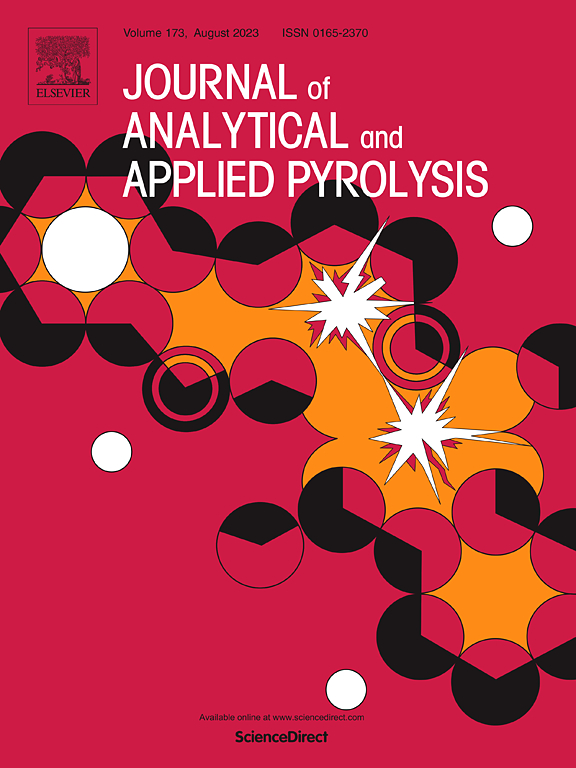1,3-二恶烷的热解和氧化:实验和动力学模型研究
IF 6.2
2区 化学
Q1 CHEMISTRY, ANALYTICAL
引用次数: 0
摘要
1,3-二恶烷(DIOX)是一种重要的合成生物燃料,有助于实现碳峰值和碳中和目标。然而,对1,3-二恶烷的热解氧化反应动力学的研究相对缺乏。为了更深入地了解1,3-二恶烷热解氧化的动力学机制,本研究对1,3-二恶烷在中温条件下进行了实验和模拟分析。用GC- ms和GC- ms测定了小分子产物和主要中间体的浓度曲线。根据典型反应类别和速率系数,建立了新的详细的动力学机理,并用实验数据进行了验证。与以前的模型相比,新机制包含了对1,3-二氧六环初始分解途径具有重要意义的碳反应。本工作通过检测关键中间体C3H5OCHO (CH3CH=CH-O-CH=O)和C2H3CHO (CH2=CH-CH=O)进一步完善了反应网络。模型分析表明,在φ = 2.0时,燃料自由基对烯烃的脱氢作用大于φ = 0.5,而在富燃料条件下,RȮ2对Q³OOH的异构化反应弱得多。反应网络分析表明,4,5-二氢-1,3-二恶英(DIOXENE)是C3H5OCHO和C2H3CHO的核心前体,也是一些小分子产物的前体。通过点火延迟时间对动力学模型进行了验证,仿真结果表明该模型能较好地反映750 K以上燃料的实际燃烧特性。总的来说,本文建立的详细模型对主要产物的浓度变化趋势和燃烧特性具有较好的预测能力。本文章由计算机程序翻译,如有差异,请以英文原文为准。
Insights into pyrolysis and oxidation of 1,3-dioxane: Experimental and kinetic modeling study
1,3-Dioxane (DIOX) is a significant synthetic biofuel that contributes to achieving carbon peak and carbon neutrality goals. However, there is a relative scarcity of research on the pyrolysis and oxidation reaction kinetics of 1,3-dioxane. To gain deeper insights into the kinetic mechanisms of 1,3-dioxane pyrolysis and oxidation, the experimental and simulated analyses of 1,3-dioxane were carried out at intermediate temperatures in this work. The concentration curves of small molecule products and major intermediates were measured using GC and GC-MS. A new detailed kinetic mechanism was developed based on typical reaction classes and rate coefficients, and validated with the experimental data. In comparison to previous models, the new mechanism incorporates carbene reactions, which are significant for the initial decomposition pathways of 1,3-dioxane. The reaction network was further refined with the detection of key intermediates C3H5OCHO (CH3CH=CH-O-CH=O) and C2H3CHO (CH2=CH-CH=O) in this work. Model analysis shows that the fuel radical dehydrogenation to olefin plays a more dominant role at than , while the isomerization reaction of RȮ2 to Q̇OOH is much weaker under fuel-rich condition. The reaction network analysis suggests that 4,5-dihydro-1,3-dioxin (DIOXENE) is the core precursor for C3H5OCHO and C2H3CHO, which are also precursors for some small molecule products. Furthermore, the kinetic model was validated against ignition delay times, and the simulated results demonstrate that the model accurately reflects the actual combustion characteristics of the fuel above 750 K. In general, the new detailed model in this work shows good prediction ability for the concentration trends of major products and combustion properties.
求助全文
通过发布文献求助,成功后即可免费获取论文全文。
去求助
来源期刊
CiteScore
9.10
自引率
11.70%
发文量
340
审稿时长
44 days
期刊介绍:
The Journal of Analytical and Applied Pyrolysis (JAAP) is devoted to the publication of papers dealing with innovative applications of pyrolysis processes, the characterization of products related to pyrolysis reactions, and investigations of reaction mechanism. To be considered by JAAP, a manuscript should present significant progress in these topics. The novelty must be satisfactorily argued in the cover letter. A manuscript with a cover letter to the editor not addressing the novelty is likely to be rejected without review.

 求助内容:
求助内容: 应助结果提醒方式:
应助结果提醒方式:


